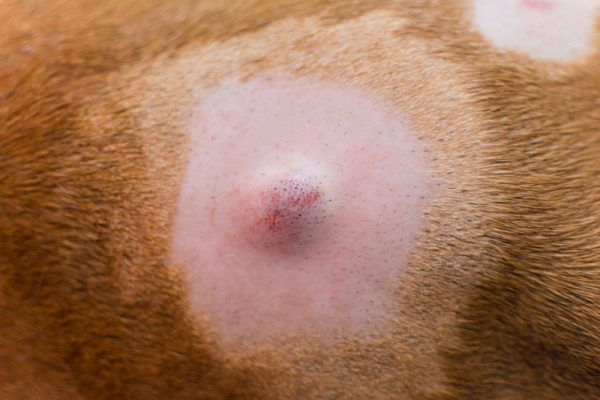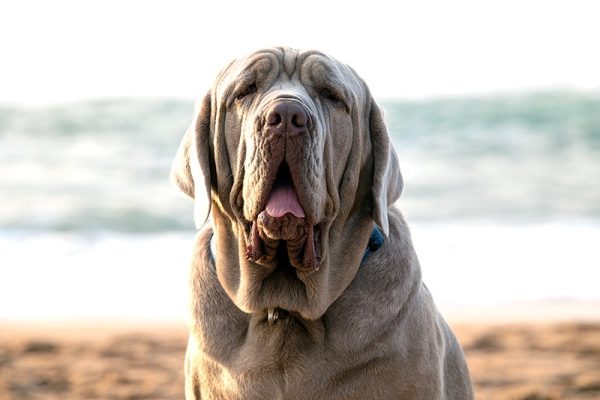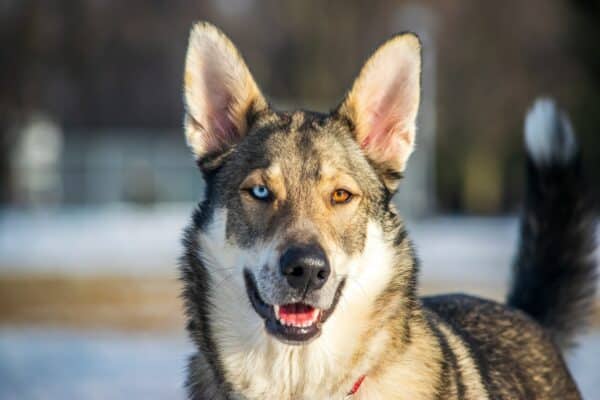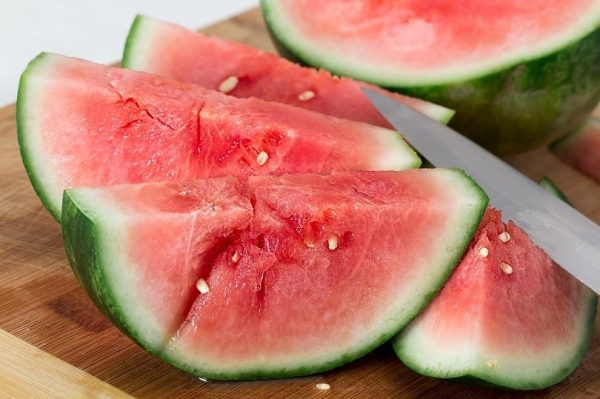In this article
View 3 More +All dogs are beautiful in different ways, but a pair of sparkling blue eyes can add a distinctive magnetism to put their looks over the top. The coloration sometimes arises as a genetic quirk, but some breeds have a tendency toward blue in one or both eyes.
So, which dogs are the most likely to have a pair of azure orbs staring back at you? We’ll discuss why and where you’ll see them in this detailed look at ten dog breeds with blue eyes.

The 10 Dog Breeds With Blue Eyes
1. Siberian Husky
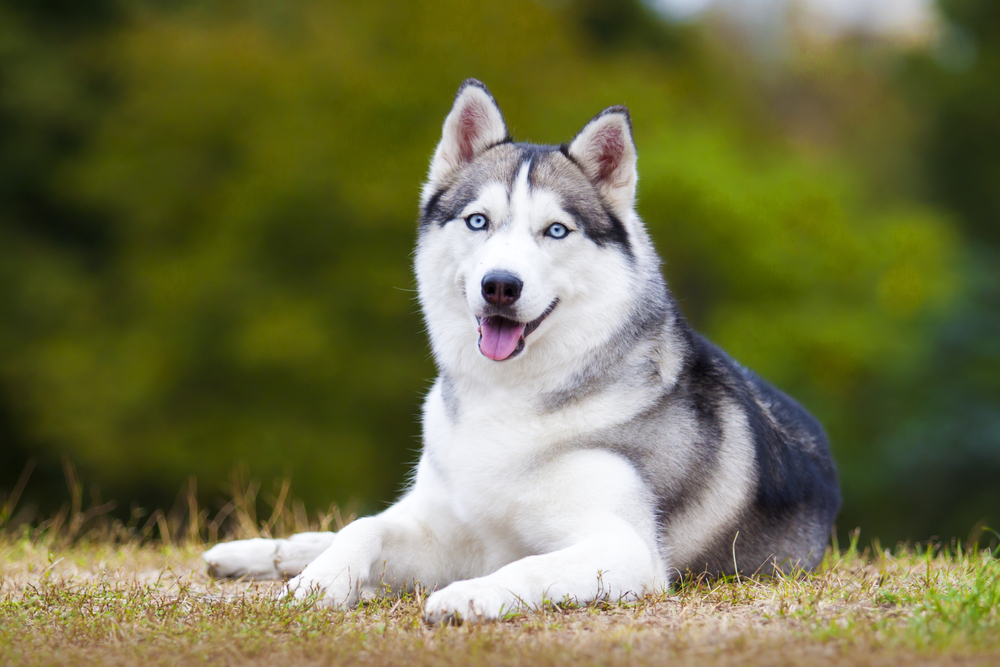
| Origin: | ~2,000–500 B.C., Siberia |
| Lifespan: | 12–14 years |
| Height: | 20–23.5 inches |
The Siberian Husky is the most notable of all blue-eyed dog breeds, with a dominant genetic tendency toward pigment-free peepers. Up to 40% of Siberian Huskies have blue in both eyes. While the rest have brown eyes, a minor percentage feature one blue and one brown (heterochromia).
Siberian Huskies originated with the Chukchi people of northeast Asia near the land bridge connecting to North America. The nomadic tribes used them as sled dogs to haul loads across the frigid, demanding landscape.
The breed’s profile rose in the 1900s as sled dog racing gained popularity. With their heroics during the 1925 Serum Run, which delivered lifesaving diphtheria medicine to Nome, Alaska, the breed cemented their place in canine lore.
Today, Siberian Huskies are one of America’s favorite family pets. Although they may be tricky to train, they delight everyone with their unconditional friendliness and desire to play.
2. Australian Shepherd

| Origin: | 1800s, USA |
| Lifespan: | 12–15 years |
| Height: | 18–23 inches |
A set of bright blue eyes often accompanies the gorgeous multi-colored merle coat defining many Australian Shepherds. Perhaps the only thing more attractive than their looks is the superior intelligence, athleticism, and trainability that made them invaluable farm workers when they appeared in the 1800s.
Despite the name, the Australian Shepherd is not a Down Under product but an American creation. The breed descended from British herding dogs and became heavily favored as Americans headed toward the Pacific during the Gold Rush. Needing a high-energy yet trainable dog to manage sheep flocks out west, ranchers developed the Aussie, a modern-day favorite pet for active families.
3. Weimaraner

| Origin: | 1800s, Germany |
| Lifespan: | 10–13 years |
| Height: | 23–27 inches |
The graceful and athletic Weimaraner was an undeniable breeding success for Germany’s Grand Duke Karl August. As an ardent outdoorsman, the duke set out to develop the ultimate hunting companion: a fleet-footed and devoted tracker and pointer for hunting large game in Germany’s forests.
As the Germans kept the talented Weimaraner a closely guarded secret, the breed didn’t arrive in America until the 1920s. They soon exploded in popularity, becoming a status symbol for several years before settling into their role as beloved family pets.
Alongside their gorgeous coat colors and sinewy frames, many Weimaraners sport a pair of beautifully subdued blue-gray eyes.
4. Border Collie

| Origin: | 1700s, England |
| Lifespan: | 12–15 years |
| Height: | 18–22 inches |
By some measures, the Border Collie is the most intelligent of all breeds. Though they’re demanding dogs, experienced and active owners find them exceptionally trainable and eager to please. These traits were developed during their time as herding dogs on the England-Scotland border.
Border Collies originated around the 1700s. Shepherds needed fast, agile dogs to manage the border’s harsh climate and coarse terrain. Rather than focus on conformation, breeders developed the dogs for herding skills, resulting in a superior breed that frequently dominates herding competitions today.
Alongside their stalking herding style, Border Collies are extra-efficient at herding because they utilize “the eye.” Border Collies can control sheep with little more than their intense stare, and their gaze becomes all the more stunning through a set of blue eyes that you may see in merle-coated dogs.
5. Dalmatian
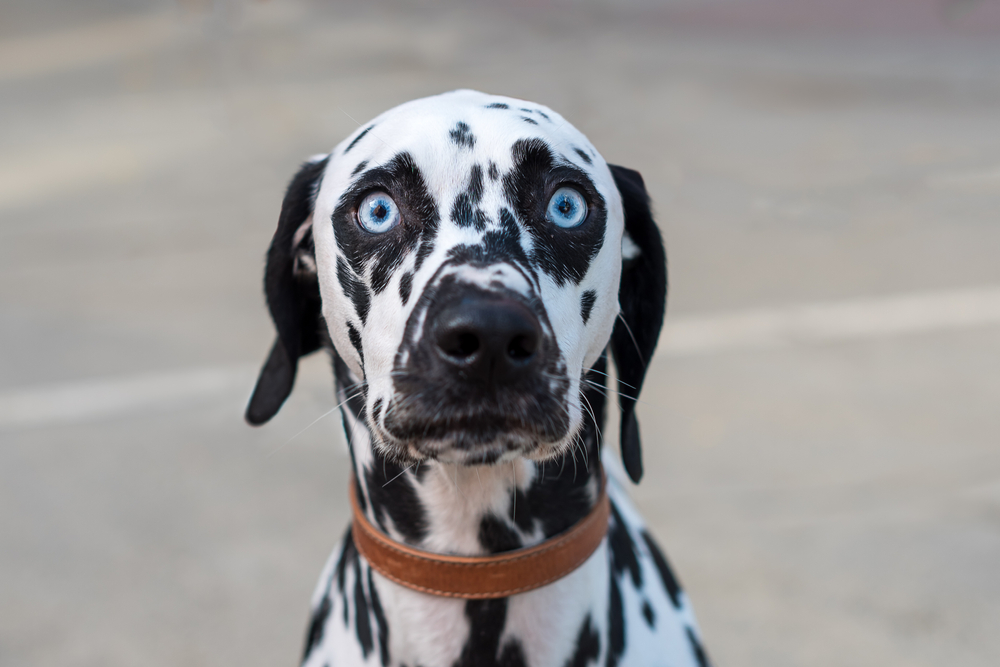
| Origin: | ~1500s, Austria |
| Lifespan: | 11–13 years |
| Height: | 19–24 inches |
Spotted dogs have appeared in various records for millennia, blurring the precise origins of the polka-dotted Dalmatian. Many believe the breed has roots with the nomadic Romani gypsies based around Dalmatia, which is an Austrian province.
The Dalmatian was a genuine jack-of-all-trades that could dispatch vermin, track and retrieve game, and pull carts. The breed even gained fame for performing in circuses, but for most people, the Dalmatian’s iconic role is that of a carriage dog.
The dog excelled as a carriage protector and fire engine assistant thanks to a rare affinity for horses, a trait as intriguing as their piebald coat, which often accompanied a set of blue eyes.
6. Shetland Sheepdog

| Origin: | ~1700s, Scotland |
| Lifespan: | 12–14 years |
| Height: | 13–16 inches |
The Shetland Sheepdog is a spritely, bright herding breed hailing from Scotland’s rugged Shetland Islands. The breed began as a tiny dog no more than 10 inches tall, supposedly resulting from a mix of smaller varieties, including Pomeranians and King Charles Spaniels.
Islanders used these dogs as versatile farm helpers to control birds and manage free-roaming livestock. As trade occurred between the Shetland Islands and the Scottish mainland, the working Collies that operated across England and Scotland influenced the breed.
Over time, the Shetland Sheepdog evolved into what looks like a miniature Rough Collie. Today’s Shelties make loyal companions and even better competitors in numerous sports, ranging from agility to obedience.
7. Cardigan Welsh Corgi

| Origin: | ~1200 B.C., Wales |
| Lifespan: | 12–15 years |
| Height: | 10.5–12.5 inches |
Despite the similar names, statures, and jobs as herding dogs, Cardigan and Pembroke Welsh Corgis couldn’t be more different. Cardigan Welsh Corgis appeared in their native Wales roughly 2,000 years before Pembrokes.
While Pembroke Welsh Corgis came from spitz-type dogs Vikings brought to Wales around 1,000 A.D., Cardigans derived from the German Teckel, which was also used to develop the Dachshund.
Like the Dachshund, the Cardigan Welsh Corgi comes in various colors, including a merle pattern that often brings out their blue eyes. With equally attractive personalities, Cardigans win the hearts of their family through their agreeable, playful temperaments and more manageable energy levels compared to their Pembroke counterparts.
8. Great Dane
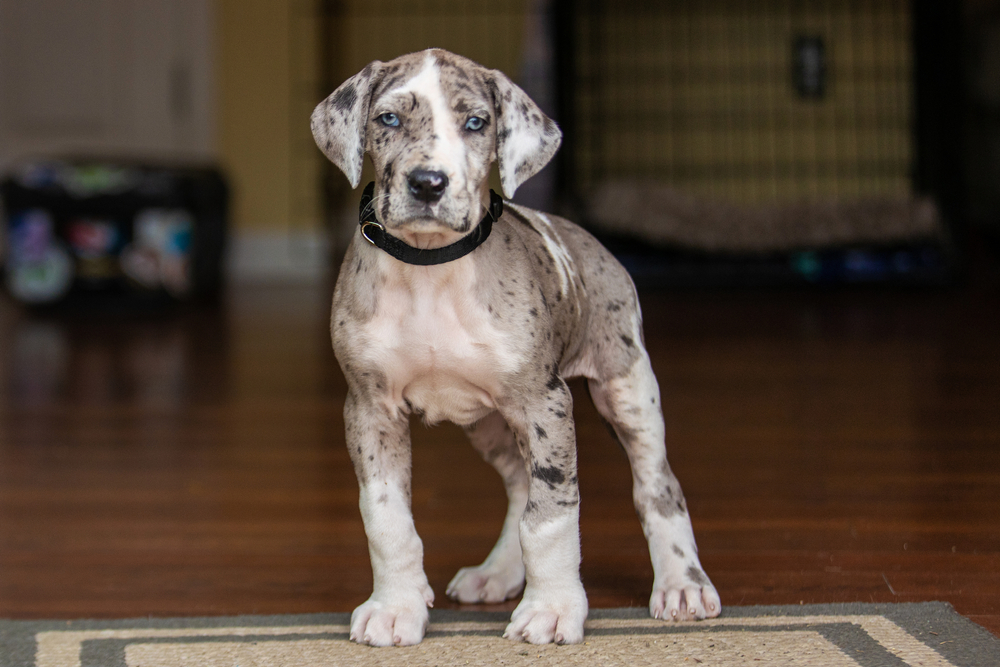
| Origin: | ~1500 B.C., Germany |
| Lifespan: | 7–10 years |
| Height: | 28–32 inches |
The enormous Great Dane is a mastiff-type dog that came about during the Middle Ages. Although their name was derived from the French Grand Danois, the misnamed Great Dane is a German product. They were fast and powerful boarhounds popular with the country’s nobles. In the late 19th century, Germany named them the national breed.
Modern Great Danes are more stable in temperament, giving us the gentle, patient giants that families love. Though attractive in any coat, some Great Danes sport a harlequin pattern, a variation of merle. Alongside the bold splotchy pattern across the body, many of these dogs have striking blue irises in one or both eyes.
9. Dachshund

| Origin: | 1600s, Germany |
| Lifespan: | 12–16 years |
| Height: | 5–9 inches |
The Dachshund, meaning “badger dog” in German, was a courageous hunting companion. Though we find them adorable today, their body shape was purposeful in every way. Their long, tubular bodies and short legs were ideal for chasing game into its burrows.
As they had to face fierce badgers head-on, Dachshunds had to be independent, determined, and fearless, which are traits that still shine today to the delight and frustration of their owners.
The dogs come in several colors and markings, including dapple. The gorgeous merle pattern brings one-of-a-kind life to the Dachshund’s coat and, in many cases, a blue hue to one or both of their eyes.
10. Beauceron

| Origin: | 1500s, France |
| Lifespan: | 10–12 years |
| Height: | 24–27.5 inches |
The Beauceron is a French herding dog developed in the Middle Ages. As a versatile worker known for loyalty and might, the large Beauceron was a valuable guardian, hunter, livestock herder, and military and police dog.
Though hardly a sensible breed for a first-time owner, experienced dog parents know these dogs are fast learners and a sensitive breed that care deeply for their families. Standing tall in their muscular bodies, Beaucerons are impressively rugged specimens.
The short, smooth double coat comes in only a few colors, including a harlequin pattern that often pairs with a set of blue eyes, a trait the official standard refers to as “walleye.”

Why Do Some Dogs Have Blue Eyes?
Blue eyes appear due to specific genes or combinations of genes affecting the pigment in the eye and, in many cases, the coat. Siberian Huskies are the breed most often associated with blue eyes, and the genetics behind this are relatively unique.
Scientists discovered Siberian Huskies boast a distinct mutation causing a highly penetrant blue eye color. A duplication in chromosome 18 appears upstream of the ALX4 gene, a gene closely connected to eye development. Researchers believe the duplication causes the ALX4 gene to suppress the MITF gene responsible for melanocyte development.
As melanocytes create melanin that provides coloration, low activity can cause a subsequent lack of pigmentation in the iris. Other than Siberian Huskies, some non-merle, tri-colored Australian Shepherds may have blue eye coloration due to the same duplication.
Piebald and Merle Dogs

The MITF gene, or S locus, causes the piebald coat patterning that commonly results in blue eyes. When dogs receive recessive alleles in this locus from their parents, they’re more likely to have patches of white across the body, with a lack of pigment extending to their blue eyes.
Meanwhile, merle dogs have dominant alleles in the PMEL gene (M locus), resulting in a patchy coat and blue irises in one or both eyes.
Since the pigment-producing melanocytes that give dogs their eye color also contribute to ocular and aural development, blue-eyed dogs are more likely to have vision or hearing problems.
Breeders must be careful to prevent unwanted combinations, such as double merles with two copies of the dominant M allele, which often result in complete deafness, blindness, and other significant health defects.
- Related read: Heterochromia in Dogs: Different Colored Eyes Explained
Why Does My Puppy Have Blue Eyes?
Although your young puppy may have stunning blue eyes now, they may be temporary. Dogs don’t produce the melanin needed to give their eyes color for several weeks after they’re born. Most newborn puppies subsequently have blue eyes. Eye color tends to come in around 9–12 weeks, though it can take up to 16 weeks to develop fully.

Conclusion
Now you know what dogs have blue eyes with these amazing breeds. While the iris color is rarely a dealbreaker for hopeful pet parents, blue eyes add a rare allure to grab attention and inspire the soul. Whether the icy blue eyes of a Siberian Husky or the subtle blue stare of a Weimaraner, the captivating gaze these blue-eyed dog breeds deliver will continually renew your appreciation for their unmatched intrigue, character, and beauty.
Featured Image Credit: Adithya_photography, Shutterstock






